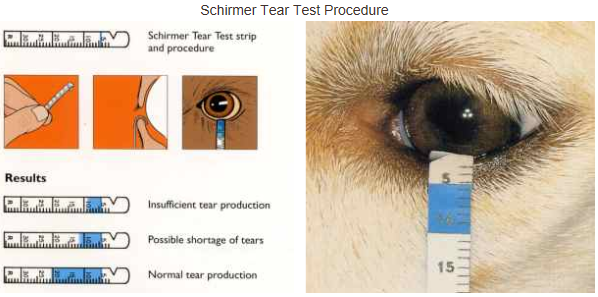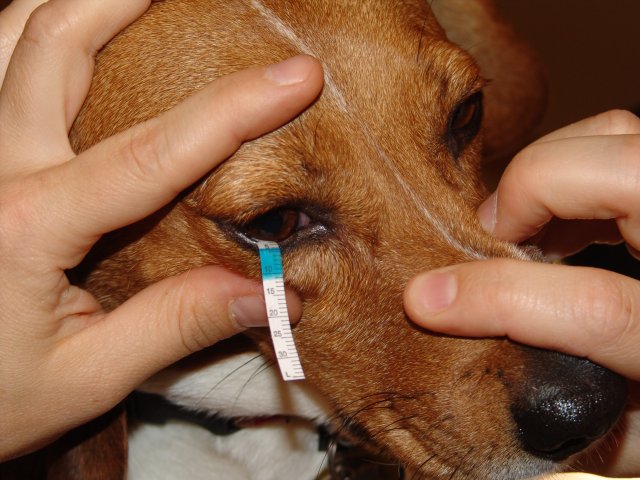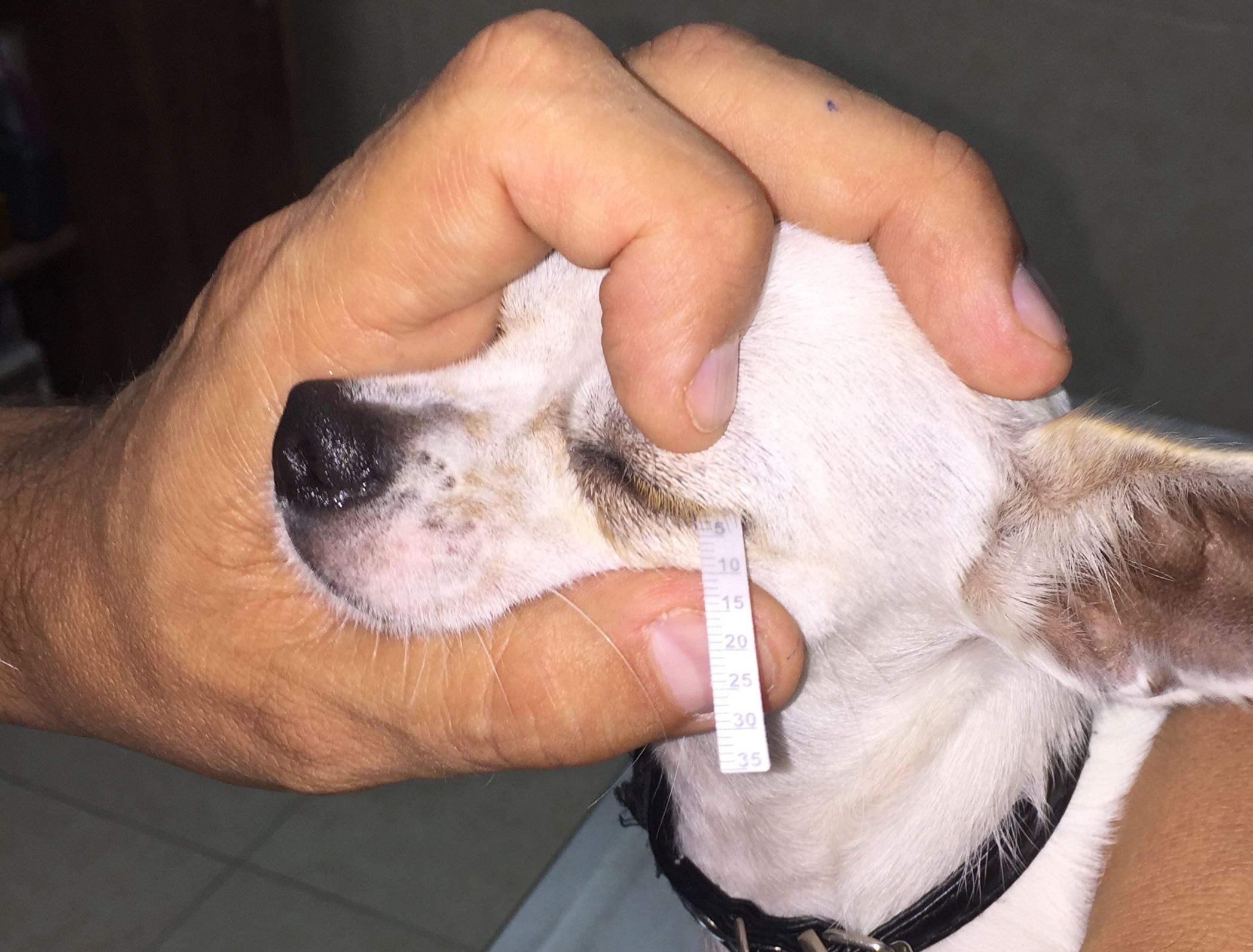normal stt dog
Dieser besteht aus einem speziellen Teststreifen der die Menge der Tränenflüssigkeit im Auge misst. A Schirmer tear test STT should be performed before the use of any drops or ointments in any dog presenting with ocular discharge irritation or corneal lesions.

Keratoconjunctivitis Sicca Kcs In Dogs Kcs In Dogs Dry Eye In Dogs Keratoconjunctivitis Sicca Treatment Tips For Keratoconjunctivitis Sicca Kcs In Dogs
KCS in a Lhasa apso dog STT reading in mmminute Interpretation Action required 0-10 Insuffi cient tear production Treatment is required 10-15 Lower than normal Treatment may be required monitoring is important 15-25 Normal --25 Normal or.

. The mean STT value for eyes with normal STT values was 229 39 mmmin mean standard deviation and the mean STT value for eyes with low STT value was 72 48 mmmin. Normal ranges are as follows. Keratoconjunctivitis sicca KCS or dry eye in the dog is a common uncomfortable and potentially blinding condition 1 most frequently diagnosed by use of the Schirmer tear test STT first developed by Otto Schirmer for quantification of tear production in people in 1903 2 and modified for use in the dog by Gelatt in 1975 3.
Ages ranged from 25 to 133 mean SEM. The thread is placed in the lower conjunctival fornix for 15 seconds and the alkaline tears change its color from yellow to orange. Dazu wird das Ende des Teststreifens in das untere Augenlid zwischen Bindegewebe und Hornhaut geklemmt.
Interpret results in light of clinical signs. Need to correlate results with clinical signs and test suspicious animals frequently to monitor for trends. Bei Verdacht auf KCS sollte zur Abklärung immer der Schirmer-Tränen-Test STT durchgeführt werden.
Normal values vary between species of animals and sometimes vary between breeds and individuals. STT1 results ranged from 0 to 26 1576 579 mmmin. Normal values are about 15 to 20 seconds.
The STT-1 was performed in 10 healthy Beagle dogs 20 eyes. Below 8 BPM. Weight and gender significantly affected STT2 results.
To establish reference values for DETs in dogs with normal STT-1 values 15 mmmin and to analyze the correlation between DETs. Most sources state that the reference range of Schirmer tear test STT values is 15 to 20 mmmin in most species. Always do a STT schirmer tear test in all cases of ocular discharge conjunctivitis and corneal disease.
In my opinion these values have to be interpreted in light of other clinical signs. A tear production of less than 15mmmin. Except for STT-1 with a normal range of 15 mmmin in dogs the reference ranges for DETs to evaluate canine KCS have not yet been established 11.
OBJECTIVE To establish a baseline range or average for tear production in normal juvenile dogs and evaluate the effects of age weight and gender on Schirmer tear test STT in juvenile dogs. Normal values are also affected by the technique used to measure them so values are usually given as a range. The phenol red test consists of a thread of 75 mm in length impregnated with phenol red which is a pH indicator.
This test is the cornerstone of quantitative KCS diagnosis. Age weight and gender significantly affect tear production in normal juvenile dogs and STT1 increases to adult values at approximately 9-10 weeks of age. Dogs investigated were all either patients seen at the Veterinary Teaching Hospital of Federal University of Paraná or normal dogs that belonged to the same institution.
A Schirmer tear test 1 STT1performed without application of surface anesthetic agentsassesses reflex tear. But when considering the STT results you must consider several factors. STT were performed in all eyes.
The mean corneal temperature was significantly lower in eyes with low STT values than in control eyes P 00001. Some animals with deficiencies in the two other portions of the tear film lipid and mucin may have normal STT but may still benefit from tear replacement therapy. These findings suggest that tear ferning could be a valuable technique for.
Age weight and gender significantly affected STT1 results. Management Images Management of Dry eye Artificial Tears There are many brands on the market and in most cases it does not matter what type you use. First older dogs frequently have STT values lower than 15 mmmin but have no clinical signs of keratoconjunctivitis sicca KCS.
For example tear osmolarities of normal dogs were 3374. STT values for eyes with abnormal ferning patterns were 109mmmin and 124mmmin these differing from the normal eyes with STT above 15mmmin significantly. For example animals that have 10 mmmin in the absence of.
After 20 min interferometry IF for estimating the lipid layer thickness LLT of the tear film tear meniscus height TMH non-invasive tear breakup time. A normal STT-1 value is 15 mm of wetting after one minute for both dogs and cats. The normal STT for a dog should be 15 mm wettingminute.
A total of 40 control eyes STT 15 mmmin and 20 eyes with low STT values STT 14 mmmin were examined. Dry eye can easily be overlooked. In other studies on DETs the results in dogs and human differed.
6174 2415 days and weights ranged from 088 to 886 327 222 kg. The median time between the first RT and the last normal STT for the control dogs was 383 days range. Dogs that are awake may not fall into this normal range as their breathing will change with exercise excitement as well as many other factors.
Sleeping Respiratory Rate SRR Ranges of a Dog in Breaths Per Minute. STT2 results ranged from 0 to 24 879 501 mmmin. Low STT-1 values are common in cats with noninflamed and otherwise normal eyes though the published normal values are similar to that of dogs.
The mean STT value for eyes. Perform a complete ophthalmic examination in all dogs presenting with new clinical signs Table 3 or disease progression. As a general rule of thumb normal STT values should be 15-25 mmminute.
Normal STT values in the dog are 15 to 25 mmminute. Some normal animals may have a low STT. Values that differ between eyes are considered significant if the difference is 8 mmHg.
A lower STT-1 value in a dog is consistent with KCS when correlated with clinical signs. The mean of absorption is 35 mm per 15 seconds. It has been suggested that 11-14 mmmin is suggestive of early KCS while 6-10 mmmin is moderate KCS and less than 5 mmminute is severe KCS.
The mean STT for dogs showing normal ferning patterns was 206mmmin for the left eye and 213mmmin for the right eye.

Strip Showing Normal Reference Value Of Tear Figure 1 Position Of Strip Download Scientific Diagram
Tear Film Deficiencies Quality Vs Quantity Vetbloom Blog

2 Simple Tests For Assessing Ophthalmic Health Clinician S Brief

Keratoconjunctivitis Sicca In Dogs The Veterinary Nurse

옵티뮨 Kcs 만성건성각결막염 Stt 옵티쉴드 옵티케어 일산동물약국 네이버 블로그
Schirmer Tear And Fluorescein Tests Hellenic Journal Of Companion Animal Medicine
Schirmer Tear And Fluorescein Tests Hellenic Journal Of Companion Animal Medicine

2 Simple Tests For Assessing Ophthalmic Health Clinician S Brief

Dry Eye In Dogs When Good Glands Go Bad Clinician S Brief

Mean And Standard Deviation Of The Schirmer Tear Test 1 Stt 1 Values Download Scientific Diagram

Stt Data For Animal Investigated Download Table

Iop And Stt Values Separated Based On Body Position In Left Lateral N Download Scientific Diagram

2 Simple Tests For Assessing Ophthalmic Health Clinician S Brief

Dry Eye In Dogs King S Ridge Veterinary Clinic

Diagnosis And Treatment Of Dry Eye In Dogs

Stt Data For Animal Investigated Download Table

2 Simple Tests For Assessing Ophthalmic Health Clinician S Brief

Scielo Brasil Comparison Of Strip Meniscometry And Schirmer Tear Test Results And Tear Film Breakup Time Between Healthy Dogs And Dogs With Dry Eye Disease Comparison Of Strip Meniscometry And

Comments
Post a Comment